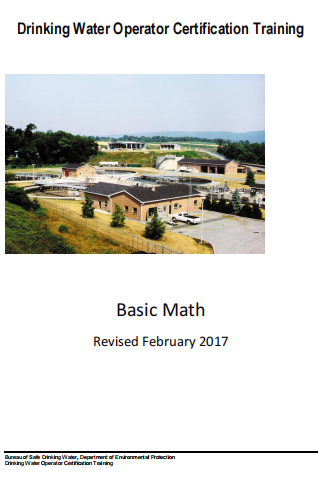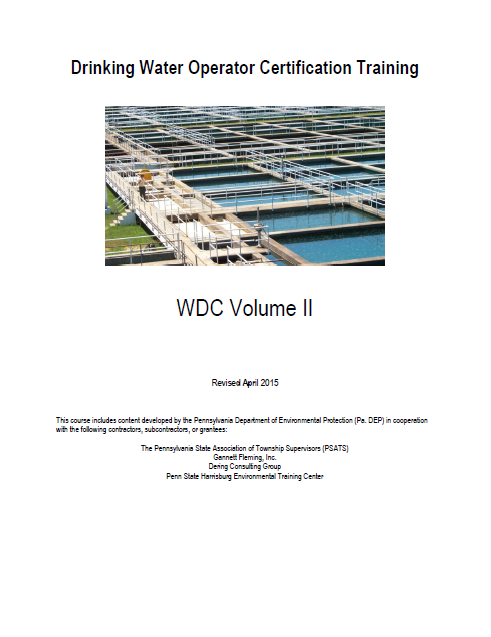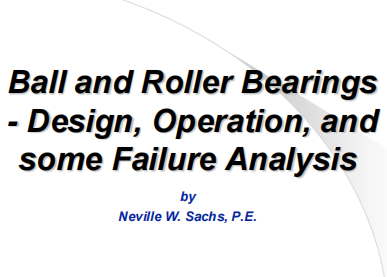Operation & Maintenance
Sand Filters Operation & Maintanence Guide
Views : 8
Usually dispatched in 2 to 3 days
Usually dispatched in 2 to 3 days
Category:
Operation & Maintenance
Only logged in customers who have purchased this product may leave a review.
Related books
Flexible Design and Operation of Multi-Stage Flash (MSF) Desalination Process Subject to Variable Fouling and Variable Freshwater Demand
Abstract:
This work describes how the design and operation parameters of the Multi-Stage Flash (MSF) desalination process are optimised when the process is subject to variation in seawater temperature, fouling and freshwater demand throughout the day. A simple polynomial based dynamic seawater temperature and variable freshwater demand correlations are developed based on actual data which are incorporated in the MSF mathematical model using gPROMS models builder 3.0.3. In addition, a fouling model based on stage temperature is considered. The fouling and the effect of noncondensable gases are incorporated into the calculation of overall heat transfer co-efficient for condensers. Finally, an optimisation problem is developed where the total daily operating cost of the MSF process is minimised by optimising the design (no of stages) and the operating (seawater rejected flowrate and brine recycle flowrate) parameters.
Flexible Design and Operation of Multi-Stage Flash (MSF) Desalination Process Subject to Variable Fouling and Variable Freshwater Demand
Abstract:
This work describes how the design and operation parameters of the Multi-Stage Flash (MSF) desalination process are optimised when the process is subject to variation in seawater temperature, fouling and freshwater demand throughout the day. A simple polynomial based dynamic seawater temperature and variable freshwater demand correlations are developed based on actual data which are incorporated in the MSF mathematical model using gPROMS models builder 3.0.3. In addition, a fouling model based on stage temperature is considered. The fouling and the effect of noncondensable gases are incorporated into the calculation of overall heat transfer co-efficient for condensers. Finally, an optimisation problem is developed where the total daily operating cost of the MSF process is minimised by optimising the design (no of stages) and the operating (seawater rejected flowrate and brine recycle flowrate) parameters.
Design Of Advanced Reverse Osmosis And Nanofiltration Membranes For Water Purification
ABSTRACT:
Most commercially available reverse osmosis (RO) and nanofiltration (NF) membranes are based on the thin film composite (TFC) aromatic polyamide membranes. However, they have several disadvantages including low resistance to fouling, low chemical and thermal stabilities and limited chlorine tolerance. To address these problems, advanced RO/NF membranes are being developed from polyimides for water and wastewater treatments. The following three projects have resulted from my research.
Design Of Advanced Reverse Osmosis And Nanofiltration Membranes For Water Purification
ABSTRACT:
Most commercially available reverse osmosis (RO) and nanofiltration (NF) membranes are based on the thin film composite (TFC) aromatic polyamide membranes. However, they have several disadvantages including low resistance to fouling, low chemical and thermal stabilities and limited chlorine tolerance. To address these problems, advanced RO/NF membranes are being developed from polyimides for water and wastewater treatments. The following three projects have resulted from my research.
Drinking Water Operator Certification Training WDC Volume II
Learning Objectives
. Define maintenance
. Discuss the roles of maintenance
. Discuss safety practices of maintenance
Drinking Water Operator Certification Training WDC Volume II
Learning Objectives
. Define maintenance
. Discuss the roles of maintenance
. Discuss safety practices of maintenance
Handbook-for-The-operation-of-Water-Treatment-Works
The term “water quality” describes the physical, chemical and microbiological characteristics of water. These properties collectively determine the overall water quality and the fitness of the water for a specific use. These properties are either intrinsic to the water or are the result of substances that are dissolved or suspended in the water. Water quality is only meaningful when evaluated in relation to the use of the water. The reason is that water of a certain quality may be fit for a specific use, but completely unfit for another use. For example, water that is fit for human consumption may not be fit as boiler feed water because the dissolved inorganic salts that are acceptable in drinking water, are not tolerated in boiler feed water, since they may precipitate and cause blockages in the boiler equipment. Water that is fit for domestic use (drinking water) must comply with specific requirements. The most important requirement is that it must be safe to drink.
Handbook-for-The-operation-of-Water-Treatment-Works
The term “water quality” describes the physical, chemical and microbiological characteristics of water. These properties collectively determine the overall water quality and the fitness of the water for a specific use. These properties are either intrinsic to the water or are the result of substances that are dissolved or suspended in the water. Water quality is only meaningful when evaluated in relation to the use of the water. The reason is that water of a certain quality may be fit for a specific use, but completely unfit for another use. For example, water that is fit for human consumption may not be fit as boiler feed water because the dissolved inorganic salts that are acceptable in drinking water, are not tolerated in boiler feed water, since they may precipitate and cause blockages in the boiler equipment. Water that is fit for domestic use (drinking water) must comply with specific requirements. The most important requirement is that it must be safe to drink.
Design Of Aerobic Granular Sludge Reactors
Introduction
Since several years, conventional wastewater treatment has been dealing with low volumetric loading rates and a high energy consumption (Van Haandel & Van der Lubbe, 2007; Pronk et al., 2017). Especially with the increasing standard of living and an increasing amount of households connected to a sewage system constant improvements are needed (Vlaamse milieumaatschappij, 2019a). The question arises how these challenges can be met in an efficient way. Over the past 20 years, aerobic granular sludge is presented as a promising technology to meet these challenges. Conventional activated sludge flocs, i.e. suspended microorganisms forming bulky aggregates, are converted into compact aerobic granules. This results in 25-75% less land area, 20-50% less energy and up to 7-17% less costs compared to conventional activated sludge plants (Pronk et al, 2017). The conventional use of aerobic granular sludge is in batch systems, but continuous systems are under research as well (Jahn et al., 2019).
The aim of this thesis is to gain further insight in continuous processes with aerobic granular sludge. Given that the current continuous systems are not depreciated, yet cannot meet the demand for higher treatment capacity, continuous aerobic granular sludge systems seem promising. Better settleability of granules could lead to higher biomass concentrations in the existing continuous systems, possibly resulting in a higher treatment capacity. Before researching how to get stable granules in a continuous flow reactor, it is needed to investigate the overall effect of granules on the performance of continuous reactors. In this thesis it is questioned if refurbishment of the current continuous activated sludge plants into continuous aerobic granular sludge plants would be advantageous in terms of treatment capacity and energy consumption, in order to meet the effluent criteria. This was investigated by developing the comparison between continuous systems with activated sludge and with aerobic granular sludge. The comparative study is obtained in different steps. In the literature review, a state-of-the-art on current wastewater treatment with activated sludge and aerobic granular sludge is given. Both the typical aerobic granular sludge implementation in batch systems and perspectives on aerobic granular sludge in continuous systems are discussed and compared based on literature findings. The chapter ‘Materials and methods’ describes the mathematical model based on the Benchmark Simulations Model No. 1 (BSM1) in Matlab-Simulink. A continuous activated sludge system serves as the reference model. Furthermore, this model is adapted to make it representable as a continuous
design with aerobic granular sludge based on two characteristics: better settleability and diffusion limitation.
In the chapter ‘Results and discussion’, the differences between both continuous systems are elucidated to answer the research question. Both the maximal treatment capacity and energy consumption in order to meet the effluent criteria were calculated and compared for both systems. Conclusions are summarized in the chapter ‘General conclusions’ and ‘Recommendations for further research’ are given.
Design Of Aerobic Granular Sludge Reactors
Introduction
Since several years, conventional wastewater treatment has been dealing with low volumetric loading rates and a high energy consumption (Van Haandel & Van der Lubbe, 2007; Pronk et al., 2017). Especially with the increasing standard of living and an increasing amount of households connected to a sewage system constant improvements are needed (Vlaamse milieumaatschappij, 2019a). The question arises how these challenges can be met in an efficient way. Over the past 20 years, aerobic granular sludge is presented as a promising technology to meet these challenges. Conventional activated sludge flocs, i.e. suspended microorganisms forming bulky aggregates, are converted into compact aerobic granules. This results in 25-75% less land area, 20-50% less energy and up to 7-17% less costs compared to conventional activated sludge plants (Pronk et al, 2017). The conventional use of aerobic granular sludge is in batch systems, but continuous systems are under research as well (Jahn et al., 2019).
The aim of this thesis is to gain further insight in continuous processes with aerobic granular sludge. Given that the current continuous systems are not depreciated, yet cannot meet the demand for higher treatment capacity, continuous aerobic granular sludge systems seem promising. Better settleability of granules could lead to higher biomass concentrations in the existing continuous systems, possibly resulting in a higher treatment capacity. Before researching how to get stable granules in a continuous flow reactor, it is needed to investigate the overall effect of granules on the performance of continuous reactors. In this thesis it is questioned if refurbishment of the current continuous activated sludge plants into continuous aerobic granular sludge plants would be advantageous in terms of treatment capacity and energy consumption, in order to meet the effluent criteria. This was investigated by developing the comparison between continuous systems with activated sludge and with aerobic granular sludge. The comparative study is obtained in different steps. In the literature review, a state-of-the-art on current wastewater treatment with activated sludge and aerobic granular sludge is given. Both the typical aerobic granular sludge implementation in batch systems and perspectives on aerobic granular sludge in continuous systems are discussed and compared based on literature findings. The chapter ‘Materials and methods’ describes the mathematical model based on the Benchmark Simulations Model No. 1 (BSM1) in Matlab-Simulink. A continuous activated sludge system serves as the reference model. Furthermore, this model is adapted to make it representable as a continuous
design with aerobic granular sludge based on two characteristics: better settleability and diffusion limitation.
In the chapter ‘Results and discussion’, the differences between both continuous systems are elucidated to answer the research question. Both the maximal treatment capacity and energy consumption in order to meet the effluent criteria were calculated and compared for both systems. Conclusions are summarized in the chapter ‘General conclusions’ and ‘Recommendations for further research’ are given.















Reviews
There are no reviews yet.